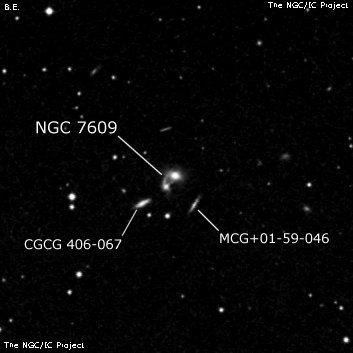
Albert Marth discovered NGC 7609 = m 570 on 5 Oct 1864 and noted "vF, vS, gbM." Although there are four galaxies here (HCG 95), it's reasonable to assign NGC 7609 to the brightest member only as it wasn't mentioned as double.
400/500mm - 17.5" (9/7/96): very faint, small, elongated 4:3 WSW-ENE, 40"x30", very little concentration. This is an interacting pair with HCG 95D attached at southeast end (not seen) and HCG 95B lies just 1.2' SE. In the background of the Pegasus I cluster.
17.5" (10/28/89): very faint, very small, stellar nucleus or star superimposed. Located 18' NNE of NGC 7601 in the Pegasus I cluster. On the POSS this is a close double galaxy with stellar nuclei. Brightest in HCG 95.
17.5" (10/12/85): faint, very small, faint stellar nucleus.
900/1200mm - 48" (10/27/16): at 488x; bright, fairly small, roundish, sharply concentrated with an intensely bright nucleus and a slightly elongated halo. NGC 7609 = HCG 95A forms an interacting system with HCG 95D 0.4' SE. HCG 95D appeared fairly faint, small, round, 12"-15" diameter. The beginning of the tidal bridge or loop connecting HCG 95D to NGC 7609 on the north side was faintly visible. MCG +01-59-048 = HCG 95B, situated 1.2' SE, appeared fairly faint to moderately bright, very elongated 7:2 NW-SE, slightly brighter core, ~30" length. Two mag 15 stars are close southwest. MCG +01-59-046 = HCG 95C, 1' SW of NGC 7609, is the faintest in the quartet and appeared as a low even surface brightness sliver, ~30"x6" NW-SE. HCG 95B is likely a a foreground galaxy based on the 2MASS redshift, with the other three forming an interacting triplet.
48" (10/23/11): bright, fairly small, slightly elongated SW-NE, 30"x25" very bright core surrounded by a fainter halo. Forms an interacting pair with HCG 95D (25" between centers) on the southeast side. At 488x the close duo was connected on the north side by a very faint loop or bridge! The tidal plume to the south of 95D (forming a partial ring) was not seen. The total size of the system is ~45"x30", oriented NW-SE.
Notes by Steve Gottlieb